The sterile packaging market is projected to grow from USD 47.9 billion in 2025 to USD 89.1 billion by 2035, at a CAGR of 6.4%. Expansion reflects the rising demand for pharmaceutical protection and medical device containment across healthcare facilities, biopharmaceutical manufacturing, surgical instruments, and diagnostic equipment sectors. The increase from USD 47.9 billion to USD 89.1 billion highlights growing adoption of barrier technology and contamination-prevention systems in hospital operations, cleanrooms, pharmaceutical distribution, and medical device applications.
Between 2025 and 2030, the market is forecast to expand from USD 47.9 billion to about USD 63.2 billion, creating USD 15.3 billion in additional value and contributing nearly 37% of decade-long growth. This stage will be characterized by adoption of advanced barrier packaging for biological drug protection and microbial contamination control. Features such as enhanced moisture barriers, particulate exclusion, and tamper-evidence will become expected requirements.
From 2030 to 2035, the market is projected to increase from USD 63.2 billion to USD 89.1 billion, generating USD 26.0 billion in added value, or 63% of total growth. This phase will be shaped by widespread use of specialized sterile containment systems, integration with pharmaceutical cold chain platforms, and compatibility with terminal sterilization and aseptic filling processes. The transition underscores a shift toward universal barrier systems and multi-therapy deployment, making sterile packaging central to pharmaceutical and medical device safety strategies.
Growth phases reveal distinct competitive dynamics. From 2025 to 2030, average annual expansion of 5.7% reflects the industry’s transition from rigid containers and basic pouches to advanced multilayer barriers with gas transmission control and improved seals. Market maturity will be supported by specification standardization, lower costs of high-performance polymers, and awareness of contamination prevention effectiveness reaching 72–78%. Leading companies such as Amcor and West Pharmaceutical Services will expand sterile portfolios, while new entrants focus on prefillable syringe formats and peelable seal solutions.
Between 2030 and 2035, the market will add USD 26.0 billion in value, driven by demand for advanced biological drug protection and universal deployment across therapeutic categories. Competitive focus will shift from maintaining sterility toward extending shelf life and ensuring compatibility with high-speed automated equipment and radiation sterilization methods, shaping the next phase of sterile packaging evolution.
A major driver of growth is the surge in biologics, vaccines, cell therapies, and high-potency injectables, which require stringent microbial control and precise environmental protection during storage and transit. Sterile packaging such as high-barrier pouches, medical-grade films, blister systems, and prefillable components ensures these sensitive formulations remain stable against oxygen intrusion, particulate exposure, and moisture fluctuations. As biologics production expands across North America, Europe, and Asia-Pacific, healthcare manufacturers increasingly depend on sterile containment with validated barrier performance.
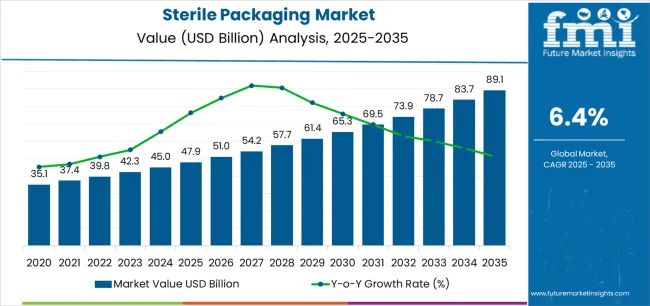
| Metric | Value |
|---|---|
| Market Value (2025) | USD 47.9 billion |
| Market Forecast (2035) | USD 89.1 billion |
| Growth Rate | 6.40% CAGR |
| Leading Material Type | Plastic Films |
| Primary Application | Pharmaceutical Products |
The sterile packaging market represents a compelling intersection of pharmaceutical protection innovation, medical device safety enhancement, and contamination prevention management. With robust growth projected from USD 47,892 million in 2025 to USD 89,324 million by 2035 at a 6.40% CAGR, this market is driven by increasing biopharmaceutical development trends, hospital infection control requirements, and commercial demand for extended shelf-life protection formats.
The market's expansion reflects a fundamental shift in how pharmaceutical manufacturers and medical device companies approach drug stability infrastructure. Strong growth opportunities exist across diverse applications, from injectable drug operations requiring aseptic packaging to surgical facilities demanding sterile instrument protection. Geographic expansion is particularly pronounced in Asia-Pacific markets, led by China (7.8% CAGR) and India (7.5% CAGR), while established markets in North America and Europe drive innovation and specialized segment development.
The dominance of plastic film systems and pharmaceutical applications underscores the importance of proven barrier technology and microbial protection in driving adoption. Material validation and sterilization compatibility remain key challenges, creating opportunities for companies that can deliver reliable performance while maintaining regulatory compliance.
Market expansion rests on three fundamental shifts driving adoption across pharmaceutical and medical device sectors. Biopharmaceutical innovation creates compelling advantages through sterile packaging systems that provide comprehensive drug stability with validated microbial barrier protection, enabling pharmaceutical companies to safeguard sensitive formulations and extend product shelf-life while maintaining potency assurance and justifying investment over standard pharmaceutical packaging. Healthcare quality standards accelerate as hospitals worldwide seek contamination-prevention systems that deliver infection control directly to surgical environments, enabling patient safety enhancement that aligns with regulatory expectations and maximizes clinical outcomes. Regulatory enforcement drives adoption from drug manufacturers requiring validated sterile packaging solutions that comply with pharmacopeial standards while maintaining traceability performance during distribution and clinical operations.
The growth faces headwinds from validation complexity variations that differ across sterilization methods regarding material compatibility and processing cycles, potentially limiting performance reliability in gamma radiation or ethylene oxide sterilization categories. Material cost premium also persists regarding high-barrier polymer systems and specialized coatings that may increase total packaging expenses in markets with demanding pharmaceutical protection standards.
Primary Classification: The market segments by material type into plastic films, glass containers, metal cans, paper & paperboard, and others categories, representing the evolution from traditional rigid pharmaceutical containers to advanced flexible barrier formats for comprehensive drug protection operations.
Secondary Breakdown: Application segmentation divides the market into pharmaceutical products, medical devices, surgical instruments, diagnostic kits, implants, and others sectors, reflecting distinct requirements for sterility maintenance, shelf-life extension, and regulatory compliance.
Regional Classification: Geographic distribution covers North America, Europe, Asia Pacific, Latin America, and the Middle East & Africa, with developed markets leading innovation while emerging economies show accelerating growth patterns driven by pharmaceutical manufacturing expansion programs.
The segmentation structure reveals technology progression from standard glass vials toward integrated multi-layer barrier platforms with enhanced gas transmission control and tamper-evident capabilities, while application diversity spans from injectable drug operations to hospital facilities requiring comprehensive sterility assurance and validated contamination-prevention solutions.
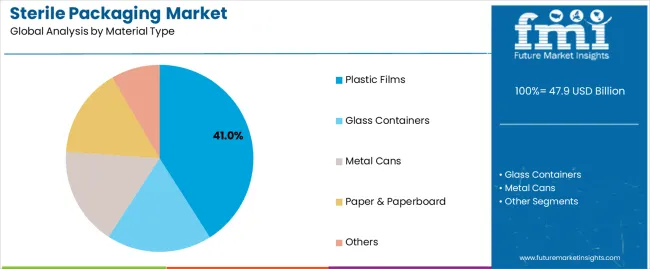
Plastic films segment is estimated to account for 41% of the sterile packaging market share in 2025. The segment's leading position stems from its fundamental role as a critical component in flexible pharmaceutical packaging applications and its extensive use across multiple drug delivery and medical device sectors. Plastic films' dominance is attributed to its superior barrier versatility, including moisture resistance, oxygen exclusion, and chemical compatibility that make it indispensable for pharmaceutical protection operations.
Market Position: Plastic film systems command the leading position in the sterile packaging market through advanced coextrusion technologies, including comprehensive layer structuring, precise thickness control, and reliable seal integrity that enable manufacturers to deploy barrier solutions across diverse pharmaceutical environments.
Value Drivers: The segment benefits from pharmaceutical manufacturer preference for proven polymer substrates that provide exceptional drug stability without requiring heavy glass containers. Efficient material usage enables deployment in unit-dose packaging, pouch systems, and blister applications where flexibility and lightweight properties represent critical selection requirements.
Competitive Advantages: Plastic film systems differentiate through excellent sterilization compatibility, proven microbial barrier performance, and integration with thermoforming equipment that enhance pharmaceutical capabilities while maintaining validated material profiles suitable for diverse drug containment applications.
Key market characteristics:
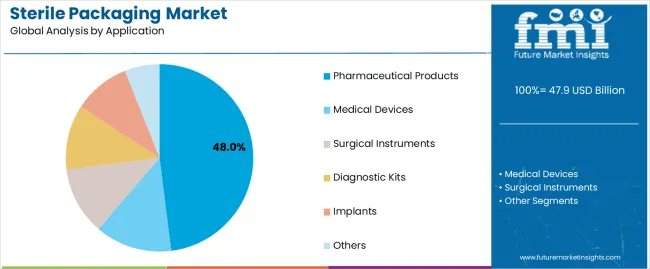
Pharmaceutical products segment is projected to hold 48% of the sterile packaging market share in 2025. The segment's market leadership is driven by the extensive use of sterile packaging in injectable drugs, oral solid medications, biological therapeutics, and specialty formulations, where contamination-free packaging serves as both a protective barrier and regulatory compliance component. The pharmaceutical industry's consistent investment in drug stability solutions supports the segment's dominant position.
Market Context: Pharmaceutical applications dominate the market due to widespread adoption of validated barrier materials and increasing focus on extended shelf-life management, microbial contamination prevention, and regulatory compliance that enhance drug efficacy while maintaining patient safety.
Appeal Factors: Pharmaceutical manufacturers prioritize barrier performance, sterilization compatibility, and integration with filling equipment that enable coordinated deployment across multiple production lines. The segment benefits from substantial biological drug growth and regulatory standards that emphasize sterile packaging for injectable pharmaceutical applications.
Growth Drivers: Biopharmaceutical expansion programs incorporate sterile packaging as standard protocol for monoclonal antibodies and specialty therapeutics. At the same time, generic drug manufacturer initiatives are increasing demand for cost-effective barrier systems that comply with pharmacopeial standards and enhance product stability.
Market Challenges: Material validation requirements and sterilization method limitations may constrain deployment flexibility in ultra-sensitive formulations or extreme temperature storage scenarios.
Application dynamics include:
Growth Accelerators: Biopharmaceutical development drives primary adoption as sterile packaging systems provide exceptional drug protection capabilities that enable formulation stability without oxidative degradation, supporting extended shelf-life achievement and regulatory compliance that require validated barrier formats. Hospital infection control accelerates market growth as medical facilities seek contamination-prevention solutions that maintain surgical instrument sterility during storage while enhancing patient safety through verified microbial exclusion design. Regulatory stringency increases worldwide, creating sustained demand for validated sterile packaging systems that complement pharmacopeial requirements and provide competitive advantages in quality assurance.
Growth Inhibitors: Sterilization compatibility challenges differ across processing methods regarding material degradation and barrier integrity maintenance, which may limit market penetration and performance reliability in radiation-sensitive categories with demanding pharmaceutical requirements. Validation cost burden persists regarding extractables testing and biocompatibility assessment that may increase total development expenses in generic drug applications with tight budget specifications. Market fragmentation across multiple material platforms and packaging formats creates standardization concerns between different pharmaceutical manufacturers and existing filling infrastructure.
Market Evolution Patterns: Adoption accelerates in biological drug and medical device sectors where regulatory compliance justifies material investments, with geographic concentration in developed markets transitioning toward mainstream adoption in emerging economies driven by pharmaceutical manufacturing expansion and healthcare quality improvement. Technology development focuses on enhanced barrier optimization, improved peel-seal mechanisms, and integration with aseptic processing systems that optimize drug stability and sterilization efficiency. The market could face disruption if alternative barrier technologies or material innovations significantly challenge plastic film advantages in pharmaceutical applications.
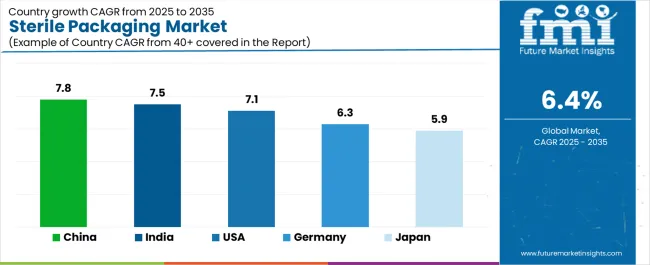
The sterile packaging market demonstrates varied regional dynamics with Growth Leaders including China (7.8% CAGR) and India (7.5% CAGR) driving expansion through pharmaceutical manufacturing growth and healthcare infrastructure modernization. Steady Performers encompass the USA (7.1% CAGR), Germany (6.3% CAGR), and Japan (5.9% CAGR), benefiting from established biopharmaceutical sectors and medical device innovation.
| Country | CAGR (2025-2035) |
|---|---|
| China | 7.8% |
| India | 7.5% |
| USA | 7.1% |
| Germany | 6.3% |
| Japan | 5.9% |
Regional synthesis reveals Asia-Pacific markets leading growth through pharmaceutical production expansion and healthcare quality enhancement, while European countries maintain steady expansion supported by specialized biological drug applications and medical device manufacturing requirements. North American markets show strong growth driven by biopharmaceutical innovation and hospital infection control applications.
China establishes regional leadership through explosive pharmaceutical production expansion and comprehensive healthcare infrastructure modernization, integrating advanced sterile packaging systems as standard components in drug manufacturing and medical device operations. The country's 7.8% CAGR through 2035 reflects pharmaceutical investment growth promoting domestic production and export market activity that mandate the use of validated sterile packaging systems in manufacturing operations. Growth concentrates in major pharmaceutical hubs, including Shanghai, Beijing, and Guangzhou, where production facilities showcase integrated sterile barrier systems that appeal to domestic drug manufacturers seeking international quality standards and export market compliance.
Chinese pharmaceutical companies are developing innovative sterile packaging solutions that combine local cost advantages with international validation specifications, including multi-layer barrier films and advanced peel-seal capabilities.
Strategic Market Indicators:
The Indian market emphasizes pharmaceutical applications, including rapid generic drug development and comprehensive contract manufacturing that increasingly incorporates sterile packaging for injectable medications and specialty formulation applications. The country is projected to show a 7.5% CAGR through 2035, driven by massive pharmaceutical production activity under government manufacturing initiatives and commercial demand for affordable, validated barrier systems. Indian pharmaceutical manufacturers prioritize cost-effectiveness with sterile packaging delivering regulatory compliance through economical material specifications and efficient validation capabilities.
Technology deployment channels include major generic drug companies, contract manufacturing organizations, and hospital supply distributors that support high-volume usage for domestic and international markets.
Performance Metrics:
The USA market emphasizes advanced sterile packaging features, including innovative biological drug containment and integration with comprehensive pharmaceutical cold chain platforms that manage drug stability, contamination prevention, and regulatory documentation applications through unified barrier systems. The country is projected to show a 7.1% CAGR through 2035, driven by biopharmaceutical innovation under specialty drug development trends and commercial demand for validated, high-performance packaging systems. American pharmaceutical companies prioritize patient safety with sterile packaging delivering comprehensive drug protection through advanced barrier technology and proven microbial exclusion.
Technology deployment channels include major biopharmaceutical companies, medical device manufacturers, and hospital purchasing organizations that support custom development for specialized operations.
Performance Metrics:
In Frankfurt, Munich, and Berlin, German pharmaceutical manufacturers and medical device companies are implementing advanced sterile packaging systems to enhance drug protection capabilities and support regulatory compliance that aligns with European Pharmacopoeia protocols and hospital standards. The German market demonstrates sustained growth with a 6.3% CAGR through 2035, driven by biological drug innovation programs and pharmaceutical investments that emphasize validated packaging systems for injectable and specialty applications. German pharmaceutical facilities are prioritizing sterile packaging systems that provide exceptional barrier integrity while maintaining compliance with extractables testing standards and minimizing contamination risk, particularly important in biological drug manufacturing and hospital device distribution operations.
Market expansion benefits from pharmaceutical quality programs that mandate validated sterility in packaging specifications, creating sustained demand across Germany's drug manufacturing and medical device sectors, where barrier excellence and regulatory documentation represent critical requirements.
Strategic Market Indicators:
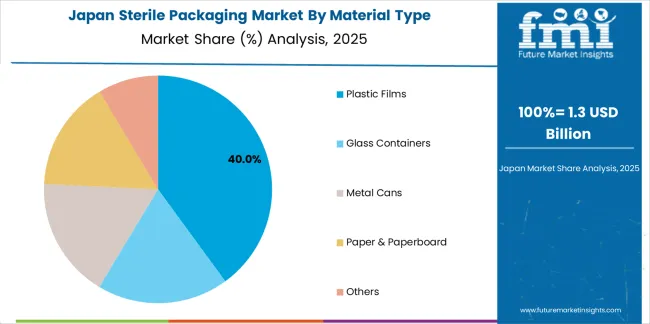
Japan's sophisticated pharmaceutical market demonstrates meticulous sterile packaging deployment, growing at 5.9% CAGR, with documented operational excellence in drug protection and medical device containment applications through integration with existing pharmaceutical manufacturing systems and quality control infrastructure. The country leverages engineering expertise in polymer science and barrier technology to maintain market leadership. Pharmaceutical centers, including Tokyo, Osaka, and Nagoya, showcase advanced installations where sterile packaging systems integrate with comprehensive aseptic filling platforms and quality assurance systems to optimize drug stability and regulatory compliance.
Japanese pharmaceutical manufacturers prioritize barrier precision and material consistency in formulation development, creating demand for premium sterile packaging systems with advanced features, including ultra-low extractables and integration with lyophilization protocols. The market benefits from established pharmaceutical infrastructure and willingness to invest in specialized barrier technologies that provide superior drug protection and regulatory documentation.
Market Intelligence Brief:
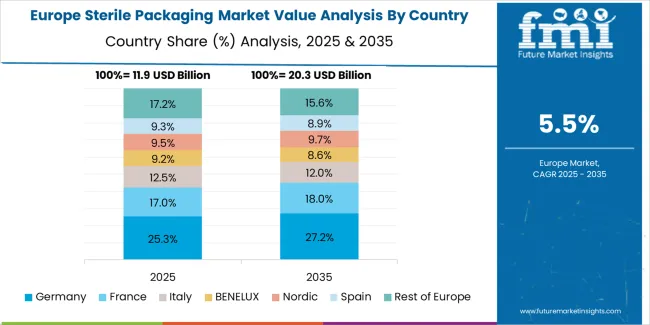
The sterile packaging market in Europe is projected to grow from USD 12,638 million in 2025 to USD 21,247 million by 2035, registering a CAGR of 5.3% over the forecast period. Germany is expected to maintain its leadership position with a 36.4% market share in 2025, declining slightly to 35.9% by 2035, supported by its pharmaceutical manufacturing excellence and major biopharmaceutical centers, including Bavaria and Baden-Württemberg.
France follows with a 24.1% share in 2025, projected to reach 24.6% by 2035, driven by comprehensive vaccine production and pharmaceutical innovation initiatives. The United Kingdom holds a 20.8% share in 2025, expected to maintain 21.2% by 2035 through established medical device sectors and hospital procurement adoption. Italy commands a 10.3% share, while Spain accounts for 6.2% in 2025. The Rest of Europe region is anticipated to gain momentum, expanding its collective share from 2.2% to 2.7% by 2035, attributed to increasing pharmaceutical manufacturing in Eastern European countries and emerging Scandinavian medical device companies implementing validated packaging programs.
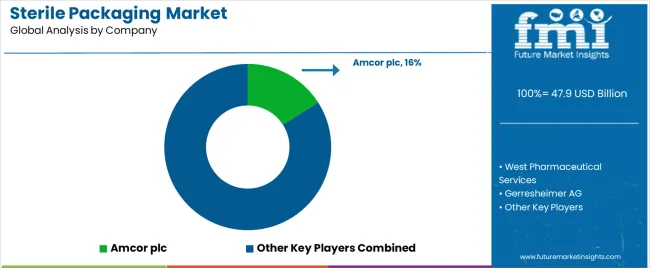
The sterile packaging market operates with moderate concentration, featuring 25–32 active participants, where the top tier controls an estimated 40–47% of global share. Competitive positioning is shaped less by price rivalry and more by regulatory compliance strength, sterility assurance performance, documentation readiness, and the ability to meet stringent pharmaceutical validation requirements. Suppliers differentiate based on microbial barrier consistency, compatibility with diverse sterilization methods, and technical service capabilities that support complex drug formulations.
Amcor plc, West Pharmaceutical Services, and Gerresheimer AG anchor the leadership tier through long-standing partnerships with global pharmaceutical and biotech companies. Their competitive advantage stems from integrated sterile barrier systems, comprehensive technical validation packages, and global cleanroom manufacturing networks that ensure continuity of supply for high-value biologics, injectables, and parenteral therapies. These companies continue to invest in advanced barrier coatings, ultra-clean polymer systems, and sustainability-aligned sterile formats designed for emerging biologics and specialty drug delivery technologies.
Challengers such as SCHOTT AG, DuPont, and Mitsubishi Chemical Group compete by leveraging material science leadership, specialty glass, engineered polymers, and protective barrier resins to address evolving requirements for extractables, leachables, and high-heat sterilization. Their innovation pipelines focus on enhancing chemical resistance, improving container integrity for biologics, and supporting pharma clients with accelerated validation frameworks.
Broader packaging manufacturers, including Berry Global Inc., Sealed Air Corporation, Bemis Company (Amcor), and Constantia Flexibles, add competitive pressure through scalable production, strong film-engineering capabilities, and cost-effective sterile barrier solutions aimed at generic injectables, medtech devices, and high-volume hospital supplies. Market dynamics increasingly favor participants that pair technical documentation rigor with advanced barrier technologies, supporting pharmaceutical clients navigating tighter regulatory oversight, biologics growth, and sterility-critical supply chain demands.
| Item | Value |
|---|---|
| Quantitative Units | USD 47.9 billion |
| Material Type | Plastic Films, Glass Containers, Metal Cans, Paper & Paperboard, Others |
| Application | Pharmaceutical Products, Medical Devices, Surgical Instruments, Diagnostic Kits, Implants, Others |
| Regions Covered | North America, Europe, Asia Pacific, Latin America, Middle East & Africa |
| Countries Covered | USA, Germany, Japan, China, India, and 25+ additional countries |
| Key Companies Profiled | Amcor plc, West Pharmaceutical Services, Gerresheimer AG, SCHOTT AG, DuPont, Mitsubishi Chemical Group, Berry Global Inc., Sealed Air Corporation, Bemis Company (Amcor), Constantia Flexibles |
| Additional Attributes | Dollar sales by material type and application categories, regional adoption trends across North America, Europe, and Asia-Pacific, competitive landscape with pharmaceutical packaging companies and material suppliers, pharmaceutical manufacturer preferences for barrier performance and sterilization compatibility, integration with aseptic filling equipment and terminal sterilization systems, innovations in multi-layer barrier technology and peel-seal mechanisms, and development of specialized biological drug solutions with enhanced shelf-life capabilities and validated contamination-prevention features |
The global sterile packaging market is estimated to be valued at USD 47.9 billion in 2025.
The market size for the sterile packaging market is projected to reach USD 89.1 billion by 2035.
The sterile packaging market is expected to grow at a 6.4% CAGR between 2025 and 2035.
The key product types in sterile packaging market are plastic films, glass containers, metal cans, paper & paperboard and others.
In terms of application, pharmaceutical products segment to command 48.0% share in the sterile packaging market in 2025.






Our Research Products

The "Full Research Suite" delivers actionable market intel, deep dives on markets or technologies, so clients act faster, cut risk, and unlock growth.

The Leaderboard benchmarks and ranks top vendors, classifying them as Established Leaders, Leading Challengers, or Disruptors & Challengers.

Locates where complements amplify value and substitutes erode it, forecasting net impact by horizon

We deliver granular, decision-grade intel: market sizing, 5-year forecasts, pricing, adoption, usage, revenue, and operational KPIs—plus competitor tracking, regulation, and value chains—across 60 countries broadly.

Spot the shifts before they hit your P&L. We track inflection points, adoption curves, pricing moves, and ecosystem plays to show where demand is heading, why it is changing, and what to do next across high-growth markets and disruptive tech

Real-time reads of user behavior. We track shifting priorities, perceptions of today’s and next-gen services, and provider experience, then pace how fast tech moves from trial to adoption, blending buyer, consumer, and channel inputs with social signals (#WhySwitch, #UX).

Partner with our analyst team to build a custom report designed around your business priorities. From analysing market trends to assessing competitors or crafting bespoke datasets, we tailor insights to your needs.
Supplier Intelligence
Discovery & Profiling
Capacity & Footprint
Performance & Risk
Compliance & Governance
Commercial Readiness
Who Supplies Whom
Scorecards & Shortlists
Playbooks & Docs
Category Intelligence
Definition & Scope
Demand & Use Cases
Cost Drivers
Market Structure
Supply Chain Map
Trade & Policy
Operating Norms
Deliverables
Buyer Intelligence
Account Basics
Spend & Scope
Procurement Model
Vendor Requirements
Terms & Policies
Entry Strategy
Pain Points & Triggers
Outputs
Pricing Analysis
Benchmarks
Trends
Should-Cost
Indexation
Landed Cost
Commercial Terms
Deliverables
Brand Analysis
Positioning & Value Prop
Share & Presence
Customer Evidence
Go-to-Market
Digital & Reputation
Compliance & Trust
KPIs & Gaps
Outputs
Full Research Suite comprises of:
Market outlook & trends analysis
Interviews & case studies
Strategic recommendations
Vendor profiles & capabilities analysis
5-year forecasts
8 regions and 60+ country-level data splits
Market segment data splits
12 months of continuous data updates
DELIVERED AS:
PDF EXCEL ONLINE
Analyzing Sterile Packaging Market Share & Industry Leaders
Sterile Barrier Packaging Market Growth - Demand & Forecast 2025 to 2035
Sterile Medical Packaging Market
Sterile and Antiviral Packaging Market Forecast and Outlook 2025 to 2035
Sterile Water Treatment System Market Size and Share Forecast Outlook 2025 to 2035
Packaging Supply Market Size and Share Forecast Outlook 2025 to 2035
Packaging Testing Services Market Size and Share Forecast Outlook 2025 to 2035
Packaging Tubes Market Size and Share Forecast Outlook 2025 to 2035
Sterile Rubber Stopper Market Size and Share Forecast Outlook 2025 to 2035
Packaging Jar Market Forecast and Outlook 2025 to 2035
Packaging Barrier Film Market Size and Share Forecast Outlook 2025 to 2035
Packaging Films Market Size and Share Forecast Outlook 2025 to 2035
Packaging Laminate Market Size and Share Forecast Outlook 2025 to 2035
Packaging Burst Strength Test Market Size and Share Forecast Outlook 2025 to 2035
Sterile Tubing Welders Market Size and Share Forecast Outlook 2025 to 2035
Packaging Tapes Market Analysis - Size, Share, & Forecast Outlook 2025 to 2035
Sterile Dosage Form Market Size and Share Forecast Outlook 2025 to 2035
Packaging Materials Market Size and Share Forecast Outlook 2025 to 2035
Packaging Labels Market Size and Share Forecast Outlook 2025 to 2035
Packaging Equipment Market Size and Share Forecast Outlook 2025 to 2035

Thank you!
You will receive an email from our Business Development Manager. Please be sure to check your SPAM/JUNK folder too.
Chat With
MaRIA